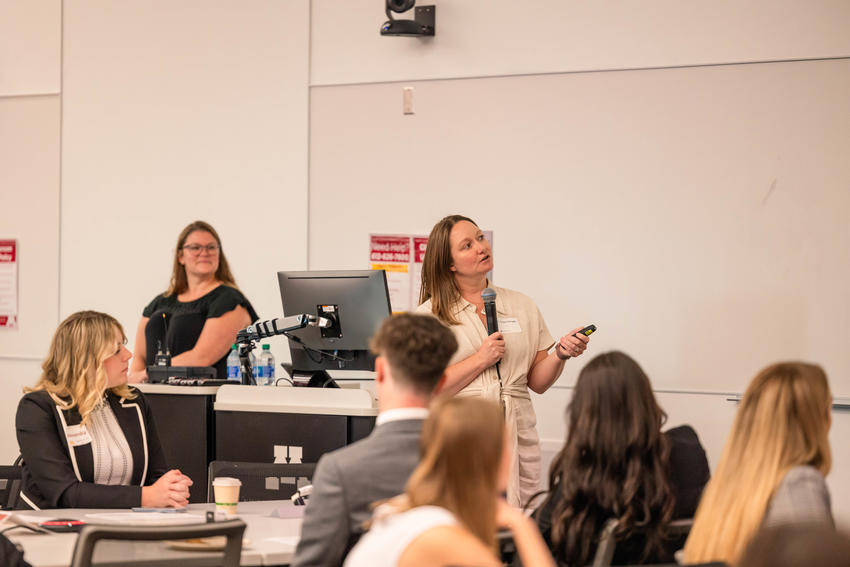StoryMaps project enhances understanding, inspires cross-curricular learning

Faculty at the School of Dentistry are working to enhance cross-subject learning with the use of innovative tools.
Kristin Shingler, PhD, teaching assistant professor of basic sciences, knows that studying basic science can be a challenge for learners.
“Basic science often feels super abstract in dentistry,” she said. “Students might not be sure why they’re learning about it, and how it relates to a person’s life and experiences.”
As a basic scientist herself, Shingler is well aware of the ways conditions learned in microbiology can impact patient care and public health, and she wanted to find ways to ensure her learners were grasping that concept. So when she saw a presentation from Shana Croson at uSpatial on StoryMaps, she knew the platform could be the perfect way to conceptualize material.
Part of spatial mapping software ArcGIS, StoryMaps are a tool for creating interactive websites that allow the user to embed spatial data, such as maps, figures and videos, to fully explore a topic. Commonly used in history and environmental sciences, the tool has been used at the University of Minnesota for course content, assessment and more.
Shingler was excited to try out the concept in her biochemistry course for first-year learners, and began with an assessment assignment focused on biochemistry and cell biology. Because of her desire to get her students to think bigger, she incorporated other areas of the curriculum into the project.
“I asked them to include at least one piece that was focused on some social determinant of health, and how that might impact someone with the disease,” she explained. “They did that, and it came out really well. It got me thinking, ‘what if we really linked this to what the students are learning in public health?’”
Shingler connected with Karl Self, DDS, MBA, Associate Dean for Academic Affairs, to see if she could more directly coordinate her course’s work with what was being taught in public health, as well as in other areas like periodontology for dental hygiene students.
The collaboration led to additional uses of StoryMaps in Shingler’s teaching, including a case study for dental hygiene students on periodontal disease and social determinants of health. Shingler worked with Michelle Arnett, RDH, MS, assistant professor of dental hygiene,as well as Meena Chandramouly, DDS PASS ’23, as part of her Academic Dental Careers Fellowship, to publish a study on the case in the Journal of Dental Education. Arnett and Shingler found that the use of StoryMaps between their classes led to a more coordinated set of curricular outcomes and improvement in examination scores.
Shingler hopes to continue implementing StoryMaps in different areas of the curriculum, perhaps even instituting a midterm assessment that pulls content from—and provides credit for—multiple courses at once.
Through the various implementations of StoryMaps, Shingler has seen an improvement in the understanding her students have of how basic sciences fit into a greater picture of health. “A lot of students incorporated public health data in meaningful ways, and students felt like the new way of looking at content was helpful for their learning,” she said. “It’s made studying basic science less abstract, to consider that they might have a patient who shows up with these issues one day.”
Students in Shingler’s classes agree, and have appreciated the opportunity to dive more deeply into the learning experience.
“I enjoyed working with my group and showcasing our knowledge in a fun and creative way,” said Kalina Yang, DDS ’27, whose assessment project focused on the biochemistry, symptoms, treatment and social determinants and context of Treacher Collins Syndrome. “The ability to view our peers’ projects on StoryMaps encouraged us to explore, learn and get inspired by one another. Along with encouraging collaboration and learning, StoryMaps enables us to present knowledge in a format that is easy to digest.”
“I feel that I could share this presentation with anyone in any field—dental, medical, or a non-health-related background. The result of the effort we put into designing the visuals and detailing the narrative is a student confident in their knowledge.”
Jamisen Hannafin, DDS ’27, said the project “gave me a chance to create something compelling to consume at the level of peers and professionals in my field.” Her group focused on Dentinogenesis Imperfecta, a genetic disorder impacting primary and permanent teeth.
“I really enjoyed that it is a more interactive platform than a presentation,” she said. “It was a great resource to connect with groups, and it made the material engaging and distinctly visual, with enough creativity to capture the attention of readers. I was very excited to share an interesting medical topic, as well as a very cool way of sharing it with others. ”
Ranya Agami, DDS ’27, “really enjoyed seeing my group’s vision of the final project come to life on screen,” she said. Agami was part of a group that created a StoryMap on Gorham-Stout Disease. They focused on biochemical aspects, treatment methods, social determinants and how to detect the disease during a dental exam. They also related the project to their Dental Public Health course by featuring hospitals that can treat the disease within the counties their public health course studied. “The end product was innovative and visually appealing, hands-on in a way essays aren’t. Instead of passively consuming information, the project allowed viewers to explore, interact and even contribute to the story, promoting deeper understanding and retention.”